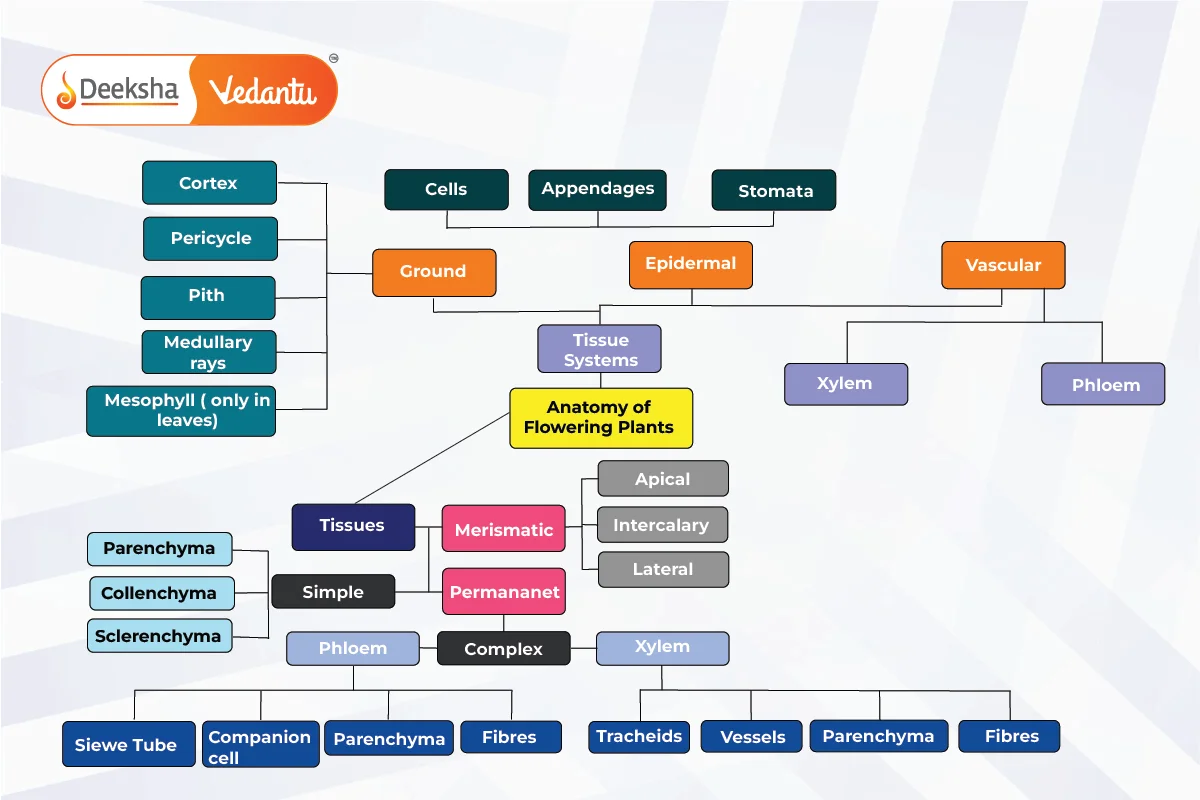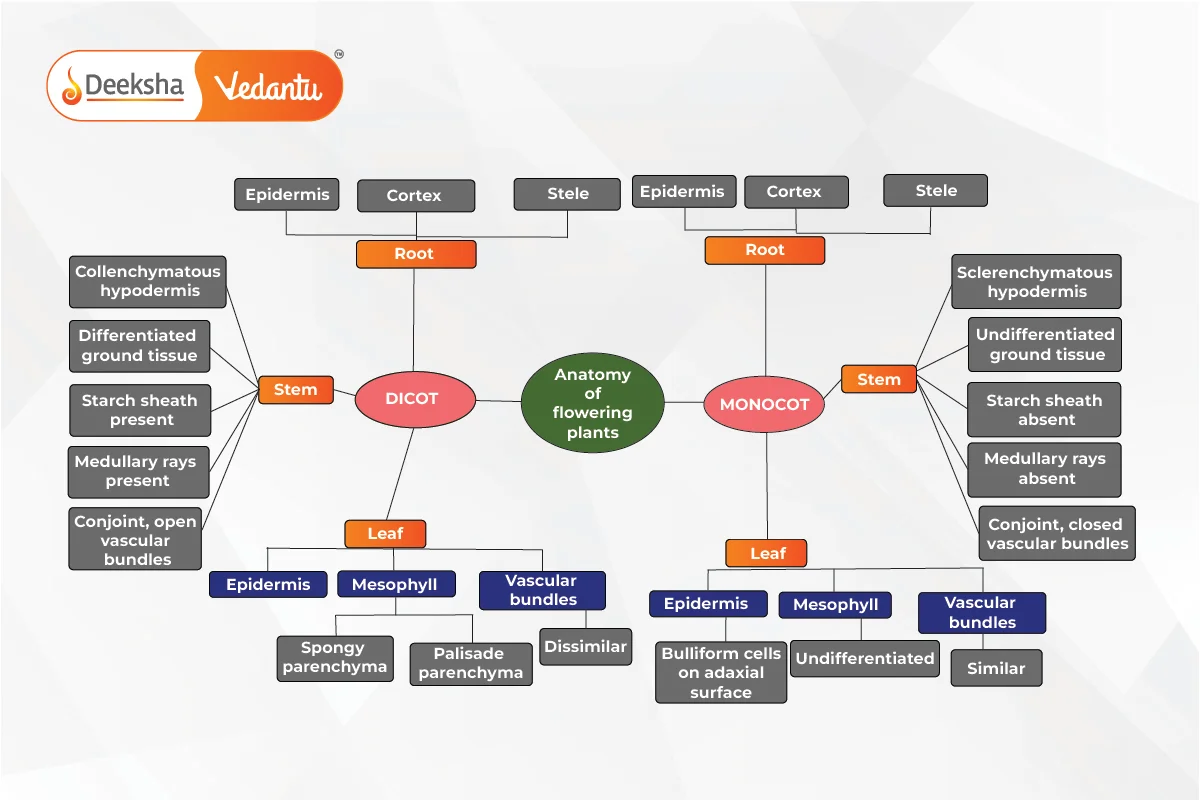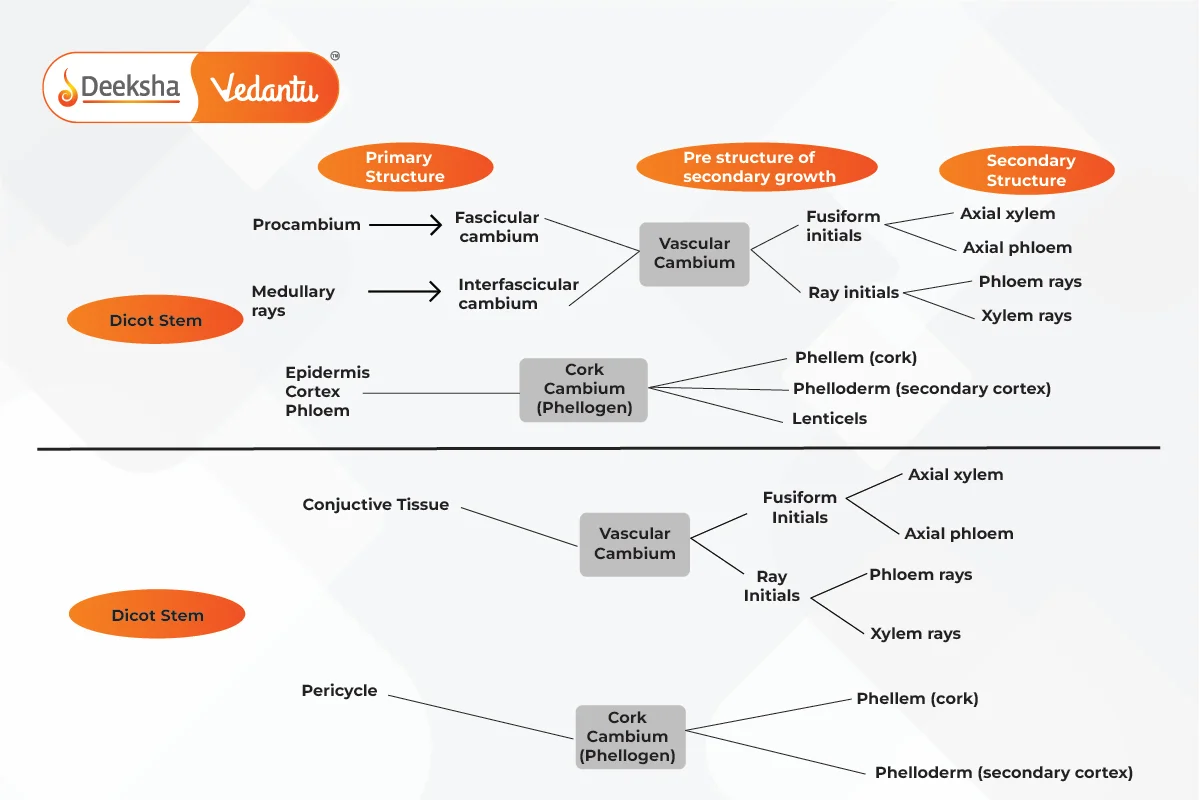Plant Tissues
- Meristematic tissue: Cells divide actively.
- Apical meristem: Occurs at the tip and produces primary tissues, e.g. dermal, vascular, and ground tissues.
- Intercalary meristem: Occurs in grasses between matured tissues.
- Lateral meristem: Produces secondary tissues, e.g. cambium.
- Permanent tissue: Cells that don’t divide further after attaining their specialized structure and function.
- Simple tissue: Only one type of cells having the same structure and function.
- Complex tissue: More than one type of cells that work in coordination.
Types of Permanent Tissue
Simple Tissue
- Parenchyma
- Structure: Cells are mostly isodiametric with thin cell walls made up of cellulose.
- Function: Photosynthesis, secretion, storage.
- Collenchyma
- Structure: Closely packed cells with no intercellular spaces; deposition of cellulose, hemicellulose, and pectin in the cell wall.
- Function: Mechanical support; chloroplast-containing cells assimilate food.
- Sclerenchyma
- Structure: Elongated cells with thick lignified cell walls; dead cells with no protoplasm; present as fibers or sclereids.
- Function: Provide mechanical support; present in the seed coat, pulp, and walls of fruits.
Complex Tissue
- Xylem
- Structure: Made up of tracheids, vessels, xylem fibers, and xylem parenchyma; vessels and tracheids are the main transporting material.
- Function: Conducts water from roots to stem and leaves.
- Phloem
- Structure: In angiosperms, phloem is made up of companion cells, sieve-tube elements, phloem parenchyma, and phloem fibers; in gymnosperms, albuminous and sieve cells are present.
- Function: Transports food.
Epidermal Tissue System
- Comprises the outer covering of the plants, such as the epidermis, cuticle, stomata, epidermal extensions; trichomes in the stem and root hairs.
- Stomata regulate gaseous exchange and water loss by transpiration.
- Guard cells are bean-shaped in dicots and contain chloroplasts; grasses have dumb-bell-shaped guard cells.
- Root hairs are unicellular; trichomes are multicellular.
The Ground Tissue System
- Forms the major bulk of tissues between epidermal and vascular tissues, e.g. cortex, pericycle, pith.
- Contains simple tissues.
- Mesophyll of leaves is a ground tissue with chloroplast.
The Vascular Tissue System

- Consists of complex tissues of xylem and phloem.
- Dicots have cambium present between xylem and phloem of the vascular bundle, forming secondary vascular tissues.
- Dicots have an open vascular bundle; monocots have a closed type of vascular bundle, i.e., cambium is absent.
- Roots have a radial arrangement of vascular bundles; stem and leaves have a conjoint arrangement of vascular bundles.
Root Structures
Dicotyledonous Root
- Epiblema is the outermost layer with root hair.
- Cortex ends with the innermost layer endodermis, which contains suberin forming Casparian strips.
- Pericycle gives rise to lateral roots and vascular cambium.
- Two to six vascular bundles present; radial and exarch vascular bundles.
Monocotyledonous Root
- Similar to dicot root but polyarch xylem bundles are present.
- Large pith and no secondary growth.
Stem Structures
Dicotyledonous Stem
- Outer epidermis with cuticle; trichomes and stomata may be present.
- Cortex consists of hypodermis, cortical layer, and endodermis containing starch grains.
- Vascular bundles arranged as a ring; conjoint, open, and with endarch protoxylem.
Monocotyledonous Stem
- Hypodermis is sclerenchymatous.
- Vascular bundles are scattered, conjoint, and closed.
Leaf Structures
Dicotyledonous Leaf (Dorsiventral)
- Reticulate venation; epidermis on both surfaces with more stomata on the abaxial epidermis.
- Mesophyll differentiated into palisade and spongy parenchyma cells.
- Vascular bundles surrounded by bundle sheath cells.
Monocotyledonous Leaf (Isobilateral)

- Parallel venation; stomata equally distributed on both sides.
- Mesophyll not differentiated; bulliform cells present in grasses.
- Vascular bundles of the same size.
Secondary Growth

- Due to dividing lateral meristems; characterized by an increase in thickness.
- Cambium forms secondary xylem and phloem.
- Earlywood and latewood form annual rings indicating tree age.
- Heartwood is hard, durable, and resistant to insects; sapwood conducts water.
- Cork cambium forms cork (phellem) and secondary cortex (phelloderm); suberin makes cork waterproof.
- Bark includes all tissues exterior to vascular cambium.
- Lenticels help in gaseous exchange.
- Absent in monocots but present in gymnosperms.
FAQs
Dicot leaves (dorsiventral) have reticulate venation, differentiated mesophyll (palisade and spongy cells), and more stomata on the lower surface. Monocot leaves (isobilateral) have parallel venation, undifferentiated mesophyll, and stomata equally distributed on both surfaces.
Lenticels are small openings on the surface of stems that allow for gas exchange between the internal tissues and the external environment, facilitating respiration and transpiration.
Secondary growth in dicot stems is due to the activity of the vascular cambium and cork cambium, which increase the thickness (girth) of the stem by forming secondary xylem and phloem.
Xylem conducts water and minerals from roots to stems and leaves, while phloem transports food from leaves to other parts of the plant.
Plant tissues are classified into two main types: Meristematic tissue (actively dividing cells) and Permanent tissue (cells that don’t divide further). Permanent tissue is further classified into Simple tissue (one type of cell) and Complex tissue (more than one type of cell).
Related Topics
- Euglena
- Types of Fermentation
- DNA Polymerases
- Marchantia
- Parenchyma Cells
- NEET Biology Weightage
- Plasmid
- Important Notes For NEET Biology – Breathing and Exchange of Gases
- What is Hemoglobin
- Nostoc
- Plasma Membrane Structure
- Epithelial Tissue
- Important Notes For NEET Biology – Cell Cycle and Cell Division
- Krebs Cycle
- Plant Hormones











Get Social